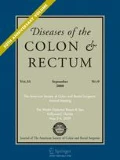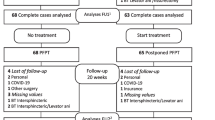Abstract
In 12 patients suffering from chronic idiopathic anal pain, the rectosphincteric function was studied using manometric and x-ray techniques. The results of manometric investigations were compared with those obtained in 12 healthy volunteers. In all patients, the resting pressure in the anal canal was significantly higher than in control subjects. In 10 patients, defecography revealed abnormalities of the pelvic muscles. We treated the patients by using biofeedback techniques, consisting of voluntary modifications of the state of contraction of the external sphincter. In all cases, pain disappeared after a mean of eight biofeedback training sessions. When noxious manifestations had disappeared, manometry showed a significant decrease in the anal canal resting pressure. Our results indicate 1) that chronic idiopathic anal pain is associated with abnormal anorectal manometric profiles, probably resulting from a dysfunctioning of the striated external anal sphincter, and 2) that biofeedback training is an effective treatment for chronic idiopathic anal pain.
Similar content being viewed by others
References
Boisson J, Debbasch L, Bensaude A. Les algies anorectales essentielles. Arch Fr Mal App Dig 1966;55:3–24.
Neill ME, Swash M. Chronic perianal pain: an unsolved problem. J R Soc Med 1982;75:96–101.
Thaysen TE. Proctalgia fugax: a little known form of pain in the rectum. Lancet 1935;2:243–6.
Swash M. Chronic perianal pain. In: Henry MM, Swash M, eds. Coloproctology and the pelvic floor. Pathophysiology and management. London: Butterworths, 1985;388–92.
Miller NE. Learning of visceral and glandular responses. Science 1969;163:434–45.
Engel BT, Nikoomanesh P, Schuster MM. Operant conditioning of rectosphincteric responses in the treatment of fecal incontinence. N Engl J Med 1974;290:646–9.
Weber J, Ducrotte P, Touchais JY, Roussignol C, Denis P. Biofeedback training for constipation in adults and children. Dis Colon Rectum 1987;30:844–6.
MacLeod JH. Management of anal incontinence by biofeedback. Gastroenterology 1987;93:291–4.
Emery Y, Descos L, Meunier P, Louis D, Valancogne G, Weil G. Constipation terminale par asynchronisme abdomino-pelvien: analyse des données étiologiques, cliniques, manométriques, et des résultats thérapeutiques après rééducation par biofeedback. Gastroenterol Clin Biol 1988;12:6–11.
Bennink CD, Hulst LL, Benthem JA. The effects of EMG biofeedback and relaxation training on primary dysmenorrhea. J Behav Med 1982;5:329–41.
Budzynski T, Stoyva J, Adler C. Feedback-induced muscle relaxation: application to tension headache. J Behav Ther Exp Psychiatry 1970;1:205–11.
Arndorfer RC, Stef JJ, Dodds WJ, Linehan JH, Hogan WJ. Improved infusion system for intraluminal esophageal manometry. Gastroenterology 1977;73:23–7.
Barnes PR, Lennard-Jones JE. Balloon expulsion from the rectum in constipation of different types. Gut 1985;26:1049–52.
Preston DM, Lennard-Jones JE. Anismus in chronic constipation. Dig Dis Sci 1985;30:413–8.
Kuijpers HC, Bleijenberg G. The spastic pelvic floor syndrome: a cause of constipation. Dis Colon Rectum 1985;28:669–72.
Mahieu P, Pringot J, Bodart P. Defecography: I. Description of a new procedure and results in normal patients. Gastrointest Radiol 1984;9:247–51.
Mahieu P, Pringot J, Bodart P. Defecography: II. Contribution of the diagnosis of defecation disorders. Gastrointest Radiol 1984;9:253–61.
Naudy B, Planche D, Monges B, Salducci J. Relaxations of the internal anal sphincter elicited by rectal and extrarectal stimulations in man. Gastroenterol Clin Biol 1983;7:725.
Schuster MM, Hookman P, Hendrix TR, Mendeloff AI. Simultaneous manometric recording of internal and external anal sphincter reflexes. Bull Johns Hopkins Hosp 1965;116:79–88.
Meunier P, Mollard P. Control of the internal anal sphincter (manometric study with human subjects). Pflügers Arch 1977;370:233–9.
West L, Abell TL, Cutts T. Anorectal manometry and EMG in the diagnosis of the levator ani syndrome. Gastroenterology 1990;98:A401.
Bartolo DC, Read NW, Jarratt JA, Read MG, Donnelly TC, Johnson AG. Differences in anal sphincter function and clinical presentation in patients with pelvic floor descent. Gastroenterology 1983;85:68–75.
Broden G, Dolk A, Frostell C, Nilsson B, Holmstrom B. Voluntary relaxation of the external anal sphincter. Dis Colon Rectum 1989;32:376–8.
Amarenco G, Lanoe Y, Ghnassia RT, Goudal H, Perrigot M. Syndrome du canal d'Alcock et névralgie périnéale. Rev Neurol (Paris) 1988;144:523–6.
Laurenti-Lions L, Gallego J, Chambille B, Vardon G, Jacquemin C. Conditionnement opérant myoélectrique chez des sujets humains ignorant le but de l'expérience (Eng abstr). CR Seances Acad Sci (III) 1982;295:325–8.
Martelli H, Devroede G, Arhan P, Duguay C. Mechanisms of idiopathic constipation: outlet obstruction. Gastroenterology 1978;75:623–31.
Loening-Baucke VA. Abnormal rectoanal function in children recovered from chronic constipation and encopresis. Gastroenterology 1984;87:1299–1304.
Ducrotte P, Denis P, Galmiche JP,et al. Motricité anorectale dans la constipation idiopathique. Etude de 200 patients consécutifs. Gastroenterol Clin Biol 1985;9:10–15.
Kuijpers HC, Strijk SP. Diagnosis of disturbances of continence and defecation. Dis Colon Rectum 1984;27:658–62.
Parks AG, Porter NH, Hardcastle J. The syndrome of the descending perineum. Proc Soc Med 1966;59:477–82.
Author information
Authors and Affiliations
Additional information
This work was supported by INSERM Grant No. 89/3h58/BCR/ CR/BD and by Fondation pour la Recherche Médicale.
About this article
Cite this article
Grimaud, JC., Bouvier, M., Naudy, B. et al. Manometric and radiologic investigations and biofeedback treatment of chronic idiopathic anal pain. Dis Colon Rectum 34, 690–695 (1991). https://doi.org/10.1007/BF02050352
Issue Date:
DOI: https://doi.org/10.1007/BF02050352




